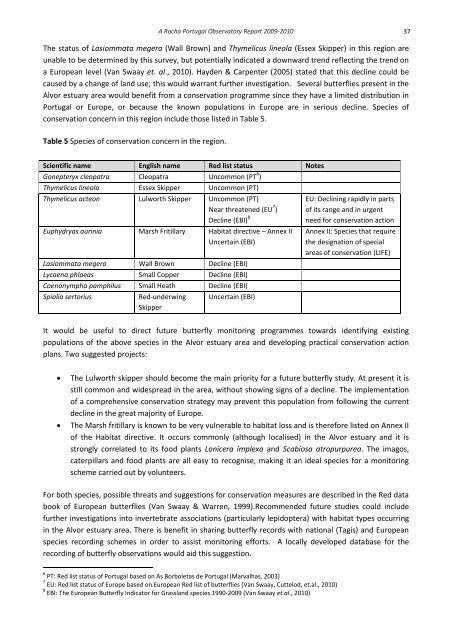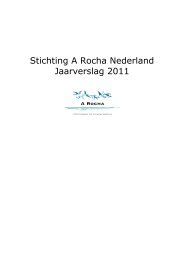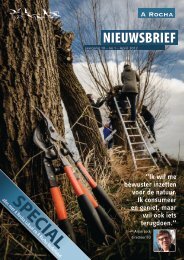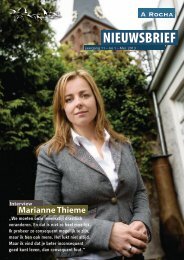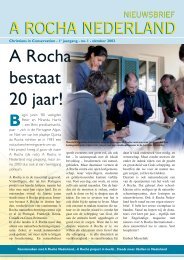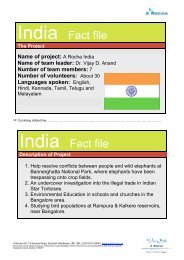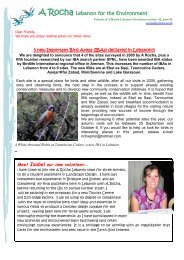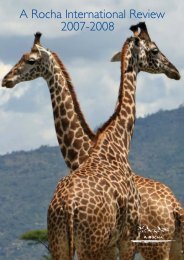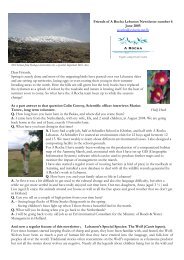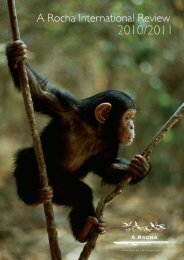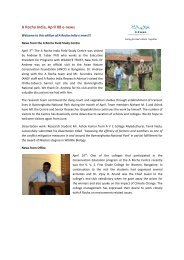A Rocha Portugal Observatory Report 2009-2010
A Rocha Portugal Observatory Report 2009-2010
A Rocha Portugal Observatory Report 2009-2010
You also want an ePaper? Increase the reach of your titles
YUMPU automatically turns print PDFs into web optimized ePapers that Google loves.
A <strong>Rocha</strong> <strong>Portugal</strong> <strong>Observatory</strong> <strong>Report</strong> <strong>2009</strong>-<strong>2010</strong> 37<br />
The status of Lasiommata megera (Wall Brown) and Thymelicus lineola (Essex Skipper) in this region are<br />
unable to be determined by this survey, but potentially indicated a downward trend reflecting the trend on<br />
a European level (Van Swaay et. al., <strong>2010</strong>). Hayden & Carpenter (2005) stated that this decline could be<br />
caused by a change of land use; this would warrant further investigation. Several butterflies present in the<br />
Alvor estuary area would benefit from a conservation programme since they have a limited distribution in<br />
<strong>Portugal</strong> or Europe, or because the known populations in Europe are in serious decline. Species of<br />
conservation concern in this region include those listed in Table 5.<br />
Table 5 Species of conservation concern in the region.<br />
Scientific name English name Red list status Notes<br />
Gonepteryx cleopatra Cleopatra Uncommon (PT 6 )<br />
Thymelicus lineola Essex Skipper Uncommon (PT)<br />
Thymelicus acteon Lulworth Skipper Uncommon (PT)<br />
Near threatened (EU 7 )<br />
Decline (EBI) 8<br />
Euphydryas aurinia Marsh Fritillary Habitat directive – Annex II<br />
Uncertain (EBI)<br />
Lasiommata megera Wall Brown Decline (EBI)<br />
Lycaena phlaeas Small Copper Decline (EBI)<br />
Coenonympha pamphilus Small Heath Decline (EBI)<br />
Spialia sertorius Red-underwing<br />
Skipper<br />
Uncertain (EBI)<br />
EU: Declining rapidly in parts<br />
of its range and in urgent<br />
need for conservation action<br />
Annex II: Species that require<br />
the designation of special<br />
areas of conservation (LIFE)<br />
It would be useful to direct future butterfly monitoring programmes towards identifying existing<br />
populations of the above species in the Alvor estuary area and developing practical conservation action<br />
plans. Two suggested projects:<br />
The Lulworth skipper should become the main priority for a future butterfly study. At present it is<br />
still common and widespread in the area, without showing signs of a decline. The implementation<br />
of a comprehensive conservation strategy may prevent this population from following the current<br />
decline in the great majority of Europe.<br />
The Marsh fritillary is known to be very vulnerable to habitat loss and is therefore listed on Annex II<br />
of the Habitat directive. It occurs commonly (although localised) in the Alvor estuary and it is<br />
strongly correlated to its food plants Lonicera implexa and Scabiosa atropurpurea. The imagos,<br />
caterpillars and food plants are all easy to recognise, making it an ideal species for a monitoring<br />
scheme carried out by volunteers.<br />
For both species, possible threats and suggestions for conservation measures are described in the Red data<br />
book of European butterflies (Van Swaay & Warren, 1999).Recommended future studies could include<br />
further investigations into invertebrate associations (particularly lepidoptera) with habitat types occurring<br />
in the Alvor estuary area. There is benefit in sharing butterfly records with national (Tagis) and European<br />
species recording schemes in order to assist monitoring efforts. A locally developed database for the<br />
recording of butterfly observations would aid this suggestion.<br />
6 PT: Red list status of <strong>Portugal</strong> based on As Borboletas de <strong>Portugal</strong> (Marvalhas, 2003)<br />
7 EU: Red list status of Europe based on European Red list of butterflies (Van Swaay, Cuttelod, et.al., <strong>2010</strong>)<br />
8 EBI: The European Butterfly Indicator for Grassland species 1990-<strong>2009</strong> (Van Swaay et.al., <strong>2010</strong>)


